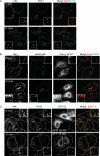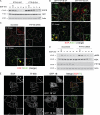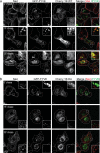Protein-tyrosine phosphatase 1B modulates early endosome fusion and trafficking of Met and epidermal growth factor receptors
- PMID: 22045810
- PMCID: PMC3247994
- DOI: 10.1074/jbc.M111.270934
Protein-tyrosine phosphatase 1B modulates early endosome fusion and trafficking of Met and epidermal growth factor receptors
Abstract
The endoplasmic reticulum-localized non-receptor protein-tyrosine phosphatase 1B (PTP1B) is associated with oncogenic, metabolic, and cytokine-related signaling and functionally targets multiple receptor tyrosine kinases (RTKs) for dephosphorylation. Loss of PTP1B activity leads to enhanced ligand-dependent biological activity of the Met RTK among others. Here, we demonstrate that knockdown of PTP1B or expression of a PTP1B trapping aspartic acid-to-alanine substitution (D/A) mutant delayed ligand-induced degradation of the Met and EGF RTKs. Loss of PTP1B function abrogated trafficking of Met and EGF receptor to Rab5- and phosphatidylinositol 3-phosphate (Pl3P)-positive early endosomes and subsequent trafficking through the degradative pathway. Under these conditions, internalization of the Met and EGF receptors was unaltered, suggesting a block at the level of early endosome formation. We show that the N-ethylmaleimide-sensitive factor (NSF), an essential component of the vesicle fusion machinery, was hyperphosphorylated in PTP1B knockdown or PTP1B D/A-expressing cells and was a target for PTP1B. NSF knockdown phenocopied PTP1B knockdown, demonstrating a mechanism through which PTP1B regulates endocytic trafficking. Finally, we show that PTP1B dephosphorylated NSF and that this interaction was required for physiological RTK trafficking and appropriate attenuation of downstream signaling.
Figures








References
Publication types
MeSH terms
Substances
Grants and funding
LinkOut - more resources
Full Text Sources
Molecular Biology Databases
Research Materials
Miscellaneous

